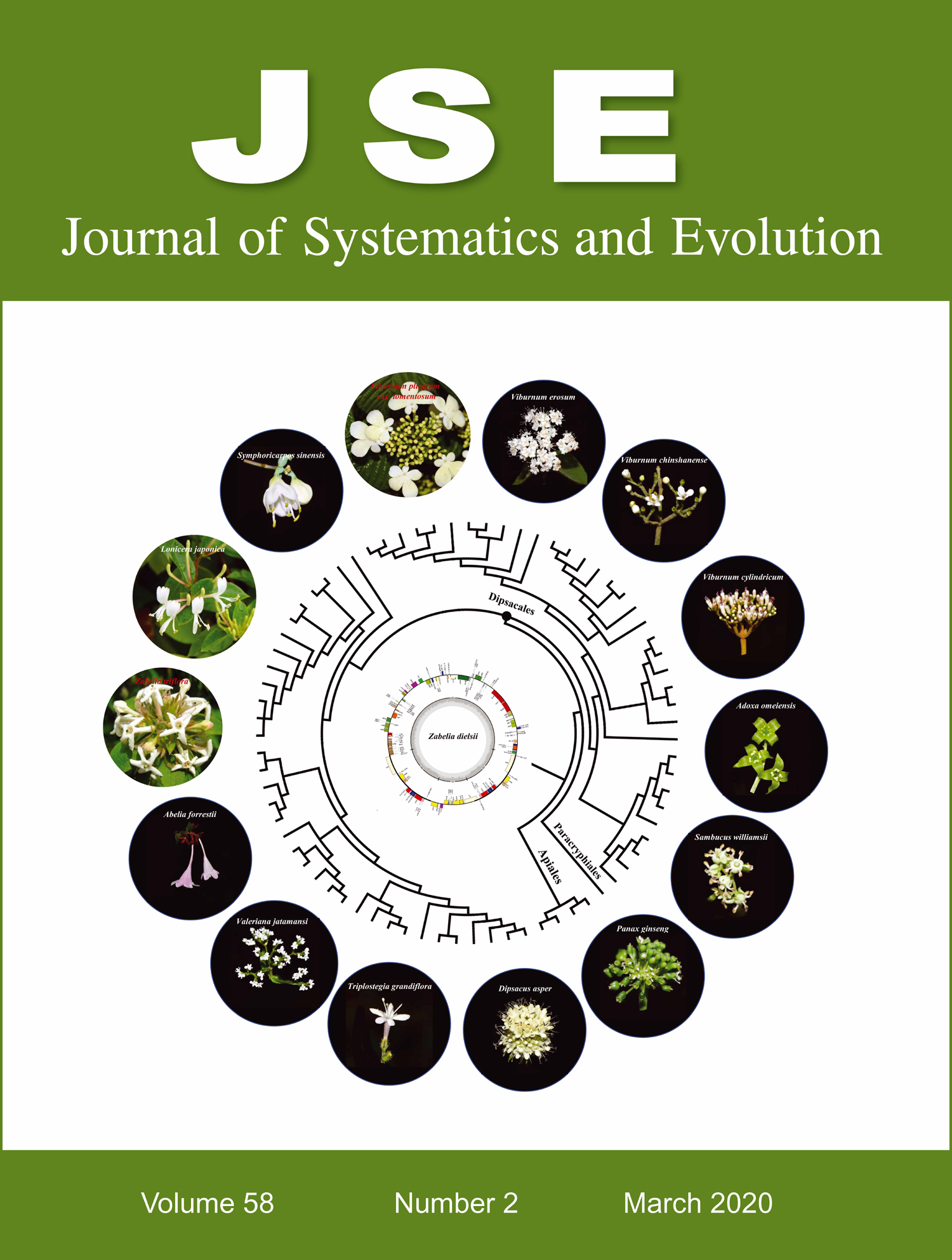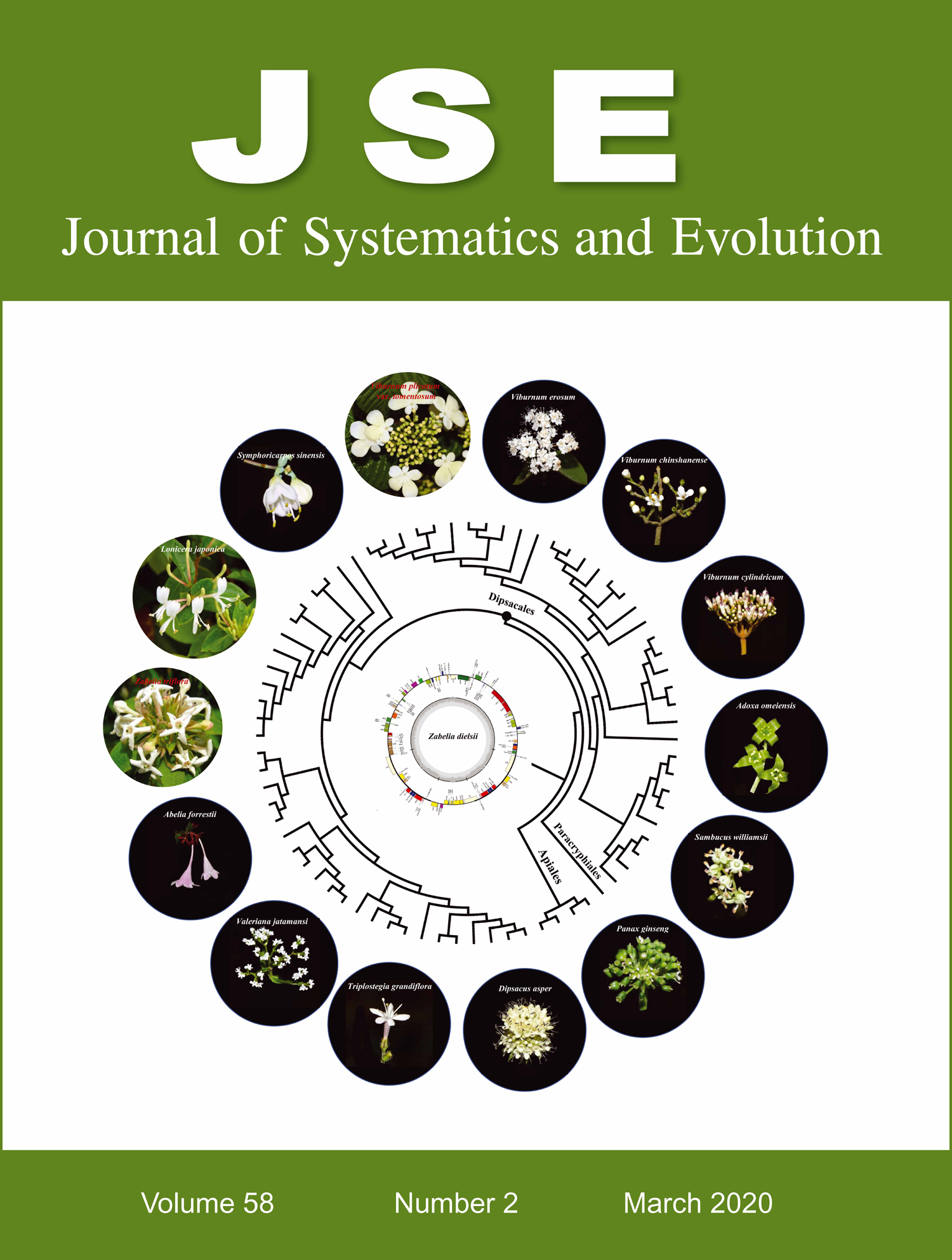


Phylogenetic relationships in Dipsacales have long been a major challenge. Although considerable progress has been made during the past two decades, questions remain; the uncertain systematic positions of Heptacodium, Triplostegia, and Zabelia, in particular, impede our understanding of Dipsacales evolution. Here we use 75 complete plastomic sequences to reconstruct the phylogeny of Dipsacales, of which 28 were newly generated. Two primary clades were recovered that form the phylogenetic backbone of Dipsacales. Seven of the primary clades correspond to the recognized families Adoxaceae, Caprifoliaceae s. str., Diervillaceae, Dipsacaceae, Linnaeaceae, Morinaceae, and Valerianaceae, and one corresponds to Zabelia, which was found to be the closest relative of Morinaceae in all analyses. Additionally, our results, with greatly increased confidence in most branches, show that Heptacodium and Triplostegia are members of Caprifoliaceae s. str. and Dipsacaceae, respectively. The results of our study indicate that the complete plastomic sequences provide a fully‐resolved and well‐supported representation of the phylogenetic relationships within Dipsacales.
Pinus L. is the largest genus of conifers and provides a classical model for studying species divergence and phylogenetic evolution by gymnosperms. However, our poor understanding of sequence divergence in the whole plastid genomes of Pinus species severely hinders studies of their evolution and phylogeny. Thus, we analyzed the sequences of 97 Pinus plastid genomes, including four newly sequenced genomes and 93 previously published plastomes, to explore the evolution and phylogenetic relationships in the genus Pinus. The complete chloroplast genomes of Pinus species ranged in size from 109 640 bp (P. cembra L.) to 121 976 bp (P. glabra Walter), and these genomes comprised circular DNA molecules in a similar manner to those of most gymnosperms. We identified 9108 repeats where most of the repeats comprised the dispersed type with 3983 (44%), followed by tandem repeats with 2999 (33%), and then palindromic repeats with 2126 (23%). Sixteen divergence hotspot regions were identified in Pinus plastid genomes, which could be useful molecular markers for future population genetics studies. Phylogenetic analysis showed that Pinus species could be divided into two diverged clades comprising the subgenera Strobus (single needle section) and Pinus (double needles section). Molecular dating suggested that the genus Pinus originated approximately 130.38 Mya during the late Cretaceous. The two subgenera subsequently split 85.86 Mya, which was largely consistent with the other molecular results based on partial DNA markers. These findings provide important insights into the sequence variations and phylogenetic evolution of Pinus plastid genomes.
Ongoing hybridization and retained ancestral polymorphism in rapidly radiating lineages could mask recent cladogenetic events. This presents a challenge for the application of molecular phylogenetic methods to resolve differences between closely related taxa. We reanalyzed published genotyping‐by‐sequencing (GBS) data to infer the phylogeny of four species within the Ophrys sphegodes complex, a recently radiated clade of orchids. We used different data filtering approaches to detect different signals contained in the dataset generated by GBS and estimated their effects on maximum likelihood trees, global FST and bootstrap support values. We obtained a maximum likelihood tree with high bootstrap support, separating the species by using a large dataset based on loci shared by at least 30% of accessions. Bootstrap and FST values progressively decreased when filtering for loci shared by a higher number of accessions. However, when filtering more stringently to retain homozygous and organellar loci, we identified two main clades. These clades group individuals independently from their a priori species assignment, but were associated with two organellar haplotype clusters. We infer that a less stringent filtering preferentially selects for rapidly evolving lineage‐specific loci, which might better delimit lineages. In contrast, when using homozygous/organellar DNA loci the signature of a putative hybridization event in the lineage prevails over the most recent phylogenetic signal. These results show that using differing filtering strategies on GBS data could dissect the organellar and nuclear DNA phylogenetic signal and yield novel insights into relationships between closely related species.
A widely held hypothesis in evolution is that adaptive specialization constrains the potential direction of future evolutionary change and thus may be irreversible, also known as Dollo's law. However, this hypothesis has long been subject to debate in evolutionary biology. Floral specialization is intriguing as it is usually linked to reproductive isolation and could affect speciation. Here, following the discovery of four new taxa, we observed some interesting phenomena of reversal versus specialization in morphology in a clade with the most specialized flowers in the genus Petrocosmea. In the phylogenetic tree based on sequences of multiple DNA regions, the morphological reversals, especially the regain of a long corolla tube, are nested within the branches characteristic of normally specialized flowers with a short corolla tube and highly specialized zygomorphy. Our results indicate that the highly specialized floral organ of this clade is still actively evolving in multiple branches toward specialization while reversals to different ancestral states occur in some branches. Great disturbance of ecological environment is likely a crucial factor affecting trait reversibility, such as the rapid uplift of the Himalayan–Tibetan plateau. The four new taxa are treated herein taxonomically. The flowers of this clade represent an interesting model to explore the genetic basis underlying the evolutionary reversal versus specialization and the interplay between genetic factors and environmental variables.
Speciation is widely accepted to be a complex and continuous process. Due to complicated evolutionary histories, desert plants are ideal model systems to understand the process of speciation along a continuum. Here, we elucidate the evolutionary history of Reaumuria soongarica (Pall.) Maxim., a typical desert plant that is wildly distributed across arid central Asia. Based on variation patterns present at nine nuclear loci in 325 individuals (representing 41 populations), we examined the demographic history, patterns of gene flow, and degree of ecological differentiation among wild R. soongarica. Our findings indicate that genetic divergence between the ancient western and eastern lineages of R. soongarica occurred approximately 0.714 Mya, probably due to the Kunlun–Yellow River tectonic movement and the Naynayxungla glaciation. Later, multiple hybridization events between the western and eastern lineages that took place between 0.287 and 0.543 Mya, and which might have been triggered by the asynchronous historical expansion of the western and eastern deserts, contributed to the formation of a hybrid northern lineage. Moreover, despite continuing gene flow into this population from its progenitors, the northern lineage maintained its genetic boundary by ecological differentiation. The northern lineage could be an incipient species, and provides an opportunity to study the continuous process of speciation. This study suggests that two opposite evolutionary forces, divergence and hybridization, coexisting in the continuous speciation of the desert plant R. soongarica in a short time. Moreover, we provide evidence that this continuous speciation process is affected by geological events, climatic change, and ecological differentiation.
A great diversity of flower morphology in orchids has long been thought to be selected by diverse pollinators. Habenaria Willd. (Orchidaceae) species are generally characterized by long nectar spurs and pollinated by long‐tongued insects (Lepidoptera), the mechanical fit between the spur and pollinator proboscis length being supposedly caused by “arms race” reciprocal selection. Here, we report that flowers of Habenaria aitchisonii Rchb. f. with nectar spurs (approximately 9 mm) were pollinated by three species of settling noctuid moths whose proboscises varied in length from 10 to 16 mm. When a settling moth crawled on the spikes and probed the flowers for nectar, pollinia were placed on the moths’ legs rather than on other body parts. Our 5‐year survey of pollinia movement and 3‐year supplemental pollination experiments indicated that fruit and seed production in this orchid were not often pollen‐limited at flower level. In a natural population in Shangri‐La, Southwest China, the proportions of pollinia removal and deposition on stigmas by moth legs were 93.8% and 83.5%, respectively. This finding of efficient pollen transfer by the pollinators’ legs in H. aitchisonii adds a new example of diverse pollinia placement on pollinators (here settling moths) in the Orchidaceae.
Local adaptation of plants along environmental gradients provides strong evidence for clinal evolution mediated by natural selection. Plants have developed diverse strategies to mitigate stress, for example, drought escape is a phenological strategy to avoid drought stress, while polyploidy was proposed as a genomic adaptation to stress. Polyploidy as an adaptation to aridity (an environmental parameter integrating temperature and precipitation) was previously documented in annual Brachypodium spp. (Poaceae) in the Western Mediterranean. Here, we examined whether polyploidy or phenology are associated with aridity in annual Brachypodium spp. along the aridity gradient in the Eastern Mediterranean. Using flow cytometry, we determined ploidy levels of plants from natural populations along the Israeli gradient, spanning ∼424 km from mesic Mediterranean to extreme desert climates. In a common garden we recorded time of seedling emergence, flowering and senescence. We tested whether the proportion of allotetraploids in the populations and phenological traits were associated with aridity. Contrary to a previous study in the Western Mediterranean, we found no effect of aridity on the proportion of allotetraploids and diploids within populations. Interestingly, phenology was associated with aridity: time of emergence was later, while flowering and senescence were earlier in desert plants. Our results indicate that in the Eastern Mediterranean, adaptation of Brachypodium to aridity is mediated mainly by phenology, rather than ploidy level. Therefore, we suggest that genome duplication is not the main driver of adaptation to environmental stress; rather, phenological change as a drought escape mechanism may be the major adaptation.